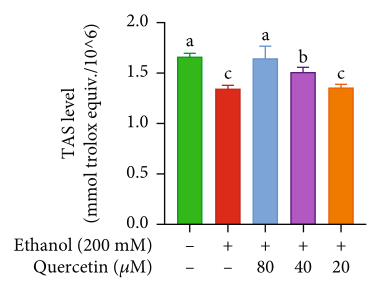Total Antioxidant Status (TAS) Colorimetric Assay Kit
SKU: E-BC-K801-M-500
Total Antioxidant Status (TAS) Colorimetric Assay Kit
| SKU # | E-BC-K801-M |
| Detection Instrument | Microplate reader (650 nm-670 nm, optimum wavelength: 660 nm) |
| Detection method: | Colorimetric method |
Product Details
Properties
| Synonyms | TAS |
| Sample type | Serum, plasma, urine, cellular supernatant, animal, plant tissue |
| Sensitivity | 0.23 mmol Trolox Equiv./L |
| Detection range | 0.23-2 mmol Trolox Equiv./L |
| Detection method |
Colorimetric method |
| Assay type | Quantitative |
| Assay time | 30 min |
| Precision | Average inter-assay CV: 7% | Average intra-assay CV: 4.600% |
| Other instruments required | Microplate centrifuge, Micropipettor, Water bath |
| Other reagents required | 60% Ethanol |
| Storage | -20℃ |
| Valid period | 12 months |
Images
X Zhao et al investigate the function of quercetin for reducing ethanol-induced hepatocyte pyroptosis. Total antioxidants status (TAS) of human L02 cell was determined using TAS colorimetric assay kit (E-BC-K801-M).

Different subscript letters indicate significant differences among the groups. (P<0.05)
Dilution of Sample
It is recommended to take 2~3 samples with expected large difference to do pre-experiment before formal experiment and dilute the sample according to the result of the pre-experiment and the detection range (0.23-2 mmol Trolox Equiv. /L).
The recommended dilution factor for different samples is as follows (for reference only):
| Sample type | Dilution factor |
| 10% Mouse liver tissue homogenate | 1 |
| 10% Rat liver tissue homogenate | 1 |
| 10% Rat lung tissue homogenate | 1 |
| Molt4 cellar supernatant | 1 |
| Human urine | 8-10 |
| Mouse serum | 1 |
| Human serum | 1 |
| Human saliva | 1 |
Note: The diluent is 60% Ethanol.
Detection Principle
ABTS is oxidized to green ABTS•+ by appropriate oxidant, which can be reduced to colorless ABTS in the presence of antioxidants. The TAS of the sample can be determined and calculated by measuring the absorbance of ABTS•+ at 660 nm. Trolox is an analog of VE and has a similar antioxidant state to that of VE. Trolox is used as a reference substance for total antioxidant status.
Kit Components & Storage
| Item | Component | Size 1(48 T) | Size 2(96 T) | Storage |
| Reagent 1 | Buffer Solution | 15 mL × 1 vial | 30 mL × 1 vial | -20℃, 12 months |
| Reagent 2 | Chromogenic Agent | 5 mL ×1 vial | 5 mL ×1 vial | -20℃, 12 months, shading light |
| Reagent 3 | 2 mmol/L Standard | 2 mL ×1 vial | 4 mL ×1 vial | -20℃, 12 months, shading light |
| Microplate | 96 wells | No requirement | ||
| Plate Sealer | 2 pieces | |||
Note: The reagents must be stored strictly according to the preservation conditions in the above table. The reagents in different kits cannot be mixed with each other. For a small volume of reagents, please centrifuge before use, so as not to obtain sufficient amount of reagents.
Technical Data:
Parameter:
Intra-assay Precision
Three human serum samples were assayed in replicates of 20 to determine precision within an assay (CV = Coefficient of Variation).
| Parameters | Sample 1 | Sample 2 | Sample 3 |
| Mean (mmol Trolox Equiv./L) | 0.87 | 1.05 | 1.46 |
| %CV | 4.8 | 4.5 | 4.5 |
Inter-assay Precision
Three human serum samples were assayed 20 times in duplicate by three operators to determine precision between assays.
| Parameters | Sample 1 | Sample 2 | Sample 3 |
| Mean (mmol Trolox Equiv./L) | 0.87 | 1.05 | 1.46 |
| %CV | 6.8 | 7.3 | 6.9 |
Recovery
Take three samples of high concentration, middle concentration and low concentration to test the samples of each concentration for 6 times parallelly to get the average recovery rate of 99%.
| Standard 1 | Standard 2 | Standard 3 | |
| Expected Conc. (mmol/L) | 0.7 | 1.35 | 1.75 |
| Observed Conc. (mmol/L) | 0.7 | 1.3 | 1.7 |
| Recovery rate(%) | 101 | 99 | 97 |
Sensitivity
The analytical sensitivity of the assay is 0.23 mmol Trolox Equiv./L. This was determined by adding two standard deviations to the mean O.D. obtained when the zero standard was assayed 20 times, and calculating the corresponding concentration.
Standard Curve
As the OD value of the standard curve may vary according to the conditions of the actual assay performance (e.g. operator, pipetting technique or temperature effects), so the standard curve and data are provided as below for reference only:
| Concentration (mmol/L) | 0 | 0.4 | 0.8 | 1.2 | 1.4 | 1.6 | 1.8 | 2 |
| Average OD | 1.196 | 0.978 | 0.818 | 0.664 | 0.583 | 0.516 | 0.436 | 0.368 |
| Absoluted OD | 0.000 | 0.217 | 0.378 | 0.532 | 0.612 | 0.680 | 0.759 | 0.827 |



